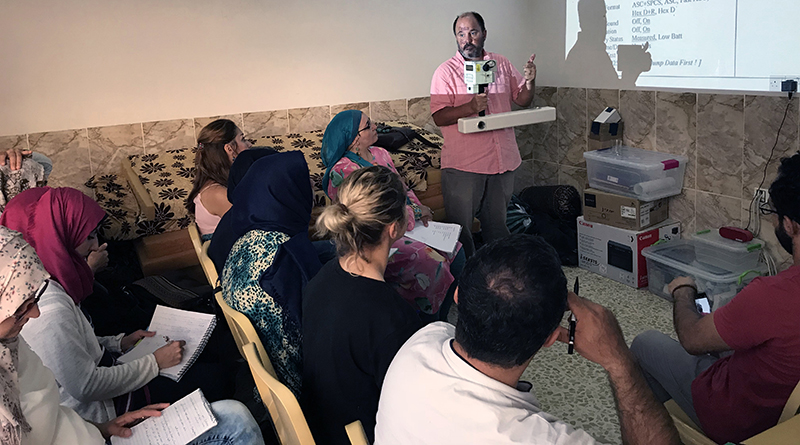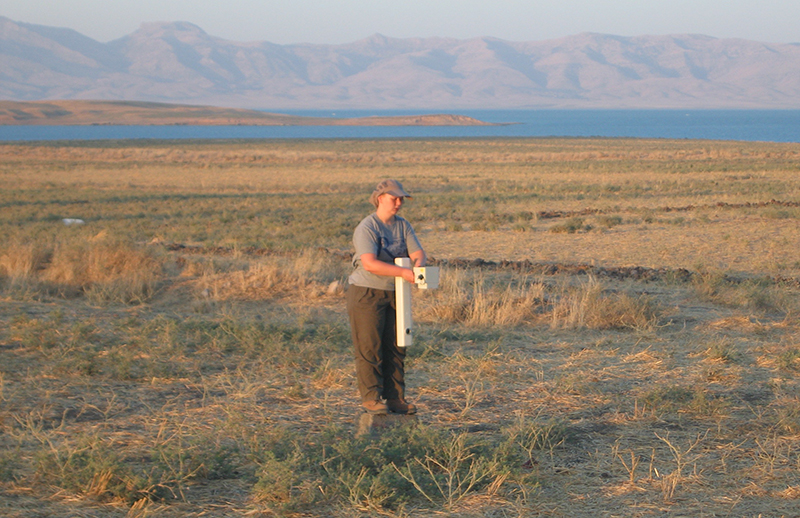Professor trains Iraqi heritage workers in cutting-edge archaeological technology
Dr. Tim Matney spent the early weeks of fall semester very far afield, but still teaching.
The professor of archaeology in the Department of Anthropology was part of an international team of archaeologists from the British Museum working in Rania in the Kurdistan region of Iraq. He was there to help train Iraqi archaeologists in the use of geophysical survey technology for mapping subsurface ancient remains. Also on the trip was alumna Morgan Revels, who earned a B.A. in Anthropology here in 2017.
Their efforts are part of the British Museum’s Iraq Emergency Heritage Management Training Scheme, a program funded by the government of the United Kingdom and delivered by the British Museum to offer up-to-date training in archaeological site management in response to the destruction of cultural heritage in Iraq. The Iraq Scheme works in cooperation with Iraq’s State Board for Antiquities of Heritage and, in the Kurdistan Region of Iraq, with the General Directorate of Antiquities of Kurdistan. Matney’s specific project was funded by the Gerda Henkel Foundation based in Düsseldorf, Germany.

Tim Matney is seen here in Iraq during one of his lectures on the use of a magnetic field gradiometer. The technology is being used by an international team of archaeologists from the British Museum to map subsurface ancient remains.
“I was asked by the British Museum to head the geophysical training because my research employing this technology in Turkey is well known,” explains Matney, who was on-site for nearly three weeks. “I also completed my B.A. in London many years ago and have long-standing contacts with the museum. I have excavated with British Museum teams, and I have worked with the project director, John MacGinnis, in Syria and Turkey.”
Sharing technical knowledge
Through a series of short workshops, Matney taught the cohort of Iraqi archaeologists and heritage managers how to use magnetic gradiometry, a technique that involves measuring minute fluctuations in the Earth’s magnetic field caused by shallow subsurface features, such as ancient architecture. Revels, who was trained on magnetic gradiometry in Matney’s course on archaeological geophysics last summer, is staying through October to continue to work with the Iraqis and to collect data.
Matney’s cohort is based at the Darband-i Rania, a pass through the Zagros Mountains in the Kurdistan region in the northeast of the country on a major route from Mesopotamia to Iran. A second cohort is based at Tello in southern Iraq, the site of a Sumerian city state of the third millennium B.C.
Two sites are being investigated — Qalatga Darband, a fortified settlement of the early Parthian period (ca. second-first centuries B.C.), that dominates the western approaches to the pass, and a smaller fortification in the pass itself dating to the time of the Neo-Assyrian empire (ca. ninth to seventh centuries B.C.).

Alumna Morgan Revels is seen here balancing the sensors on the magnetic field gradiometer. She will collect data with the Iraqis in Iraqi Kurdistan until the end of October.
The focus of the fieldwork is mapping a massive 150-meter square installation at Qalatga Darband. The feature was discovered through the analysis of declassified Corona satellite imagery dating to the 1960s. While too large to excavate extensively, the use of geophysical remote is the ideal method for mapping the interior layout of the installation, says Matney, while at the same time providing training to the Iraqi archaeologists participating in the scheme.
Opportunities beyond the classroom
“I frequently take on projects that allow me an opportunity to train students in geophysical survey outside of the normal classroom setting,” notes Matney. “Typically, these are projects in northeastern Ohio as part of our department’s long-standing outreach in community archaeology. More rarely, I am able to take UA students abroad – most recently to Turkey, India and Azerbaijan. In my current project, I was lucky enough to work with a cohort of Iraqi archaeologists and my former student was able to assist me in the training and fieldwork. I use geophysics in my own research, of course, but this was primarily a teaching opportunity.
“My students have been involved in projects across the world using geophysical survey technologies in archaeology,” adds Matney. “It is a great opportunity for them to experience other cultures, meet a variety of scholars in different fields, and to put into practice the lessons learned in the classroom.”
